There’s a simple way to make the backyard a little wilder even if you call the city home.
by Becca Cahall
We’ve all seen children’s eyes widen at the sight of a butterfly weaving across a backyard breeze or deer grazing at the fence line. Kids dig animals. Helicopters are also pretty cool. In the animal kingdom, the rapidly beating, invisible wings of a darting hummingbird are as close as it gets to whirling rotors.
Hummingbirds eat a lot — they consume approximately 2/3 of their body weight every day. So when an easy source of sustenance appears, hummingbirds take full advantage of a free meal. It’s kind of like offering your climbing bum friends the leftover pizza in the fridge. Many people put hummingbird feeders in their yard to catch a close up glimpse of a species that never seems to be in one place for long. Over 15 different species have been recorded in the U.S. While most are restricted to warm places (S. Texas, Arizona and New Mexico), a few common species are distributed across the U. S. You and your kids can make a feeder from materials that you have around the house. It’s a quick project, which will yield results later in the spring.
Materials needed
- Small jar with a lid (spice jars work well)
- Tool to make holes in lid (hammer and small nail, awl, etc.)
- String or stiff wire (coat hanger)
- Water
- Sugar
Optional
- Red paint
- Fake flowers
- Beads
- Glue
Directions
1. Clean jar thoroughly, rinse clear of soap, and dry.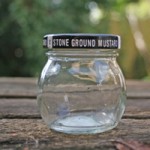
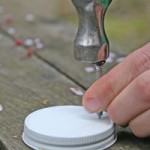 2. With tool, punch 3 smallish holes in a semicircle in jar lid. Make them somewhat close together. Make sure the lid still attaches properly.
2. With tool, punch 3 smallish holes in a semicircle in jar lid. Make them somewhat close together. Make sure the lid still attaches properly.
3. After punching, make sure that there are not sharp fragments that the hummingbirds can cut their tongues on. I hammered the rough edges to flatten them, and then used some sandpaper for fine-tuning.
4. Hummingbirds love red. Put some red on your feeder- paint, beads or other items you may have around the house. But, don’t use red food dye in the sugar water as the chemicals are harmful to hummingbirds.
5. Wrap string/wire around mouth of jar. Make sure the knot is opposite the holes in the lid. You can use hot glue or super glue to secure if you like.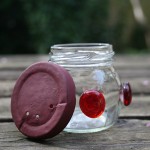
6. Fill jar about three quarters full with sugar water (see below). Make sure that you keep the jar upright until you hang it outside as it may drip initially.
7. Mix 4 parts hot water to 1 part sugar. Stir to dissolve. Cool completely before placing in the feeder. Remaining sugar water can be kept in the fridge for about 2 weeks. Discard the sugar water in the feeder every 4-7 days to ensure that mixture does not ferment – you don’t want this turn into a lesson on how alcohol impairs motor skills. Rinse jar, and replace with new sugar water.
8. Hang the feeder from a tree branch or from your home’s eaves.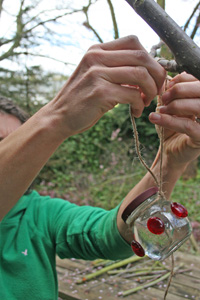
Fun facts and teaching points for kids
- Hummingbirds flap their wings about 50 times a second. See how many arm flaps your child can do in 10 seconds.
- Hummingbirds have to feed about every 10 minutes. In general, smaller animals eat more food gram for gram of body weight than larger animals. For example, for each gram of body weight, a mouse consumes 10 times more calories than an elephant. This might explain why your kids’ stomachs seem like bottomless pits. While maintaining a constant body temperature might explain this pattern in endotherms (mammals, birds), this pattern is also observed in ectotherms (reptiles, amphibians). Scientists continue to research the underlying causes of this physiological phenomenon.
- Hummingbirds lap nectar with their long tongue. When not in use, the tongue wraps under their jaw, then behind and over their head. Hummingbirds help pollinate a plant when they take nectar by transferring pollen from flower to flower. Hummingbirds and certain flower species have coevolved. The reproductive success of both species improved, and natural selection reinforced these interactions.
- Hummingbirds have good memories. They remember food sources year after year. So when your favorite backyard hummer leaves for the winter, remember to put your feeder back out again in the spring.
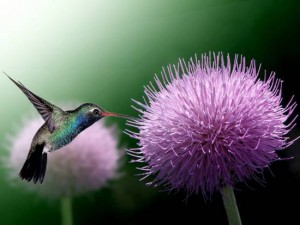 If you want to try and identify the hummingbird that vists your feeder, check out the Cornell Lab of Ornithology. Search for hummingbird and check out the photos and range maps.
If you want to try and identify the hummingbird that vists your feeder, check out the Cornell Lab of Ornithology. Search for hummingbird and check out the photos and range maps.
More info at Gardening With Kids.

Looks like a fun, easy little project. Less expensive than constantly buying bird feed. And, I am guessing hummingbirds poop a lot less than the birds attracted by birdseed!!!
We’re building one tonight! One tip might be to actualy boil the water, as city water is full of “other” stuff.
Thanks Becca!
cool. Let us know how it turns out. It’s a little quiet up in Seattle for hummingbird action. Soon though.
My five year old son and I made one this past rainy weekend. The only potential problem is that we used an old jar of Lee Kum Kee black bean garlic paste. Hopefully, the hummingbirds won’t be turned-off by it’s lingering scent. I’ve got pics of the finished product at http://empirerunning.blogspot.com/.
Thanks for the idea Outdoor Parent.
you never know…everyone likes garlic
so cool, will build on now!!
Thanks so much for posting this!! I would like to quickly re-emphasize the importance of changing the sugar water very regularly because it spoils. Here is a feeding hints link http://tinyurl.com/dmzaw8
Thank you for the great info. I have just put out a humming bird feeder then when i went online to find out some tips.